[English] 日本語
 Yorodumi
Yorodumi- PDB-1t2v: Structural basis of phospho-peptide recognition by the BRCT domai... -
+ Open data
Open data
- Basic information
Basic information
| Entry | Database: PDB / ID: 1t2v | ||||||
|---|---|---|---|---|---|---|---|
| Title | Structural basis of phospho-peptide recognition by the BRCT domain of BRCA1, structure with phosphopeptide | ||||||
 Components Components |
| ||||||
 Keywords Keywords | ANTITUMOR PROTEIN / BRCT / BRCA1 / breast cancer / cell signaling / missense mutation / phosphopeptide | ||||||
| Function / homology |  Function and homology information Function and homology informationhistone H2AK127 ubiquitin ligase activity / histone H2AK129 ubiquitin ligase activity / Defective DNA double strand break response due to BRCA1 loss of function / Defective DNA double strand break response due to BARD1 loss of function / BRCA1-BARD1 complex / BRCA1-B complex / BRCA1-A complex / BRCA1-C complex / negative regulation of centriole replication / sex-chromosome dosage compensation ...histone H2AK127 ubiquitin ligase activity / histone H2AK129 ubiquitin ligase activity / Defective DNA double strand break response due to BRCA1 loss of function / Defective DNA double strand break response due to BARD1 loss of function / BRCA1-BARD1 complex / BRCA1-B complex / BRCA1-A complex / BRCA1-C complex / negative regulation of centriole replication / sex-chromosome dosage compensation / random inactivation of X chromosome / ubiquitin-modified histone reader activity / chordate embryonic development / nuclear ubiquitin ligase complex / cellular response to indole-3-methanol / gamma-tubulin ring complex / negative regulation of intracellular estrogen receptor signaling pathway / DNA strand resection involved in replication fork processing / negative regulation of fatty acid biosynthetic process / homologous recombination / Regulation of MITF-M-dependent genes involved in DNA replication, damage repair and senescence / protein K6-linked ubiquitination / lateral element / regulation of DNA damage checkpoint / Impaired BRCA2 binding to PALB2 / XY body / mitotic G2/M transition checkpoint / RNA polymerase binding / DNA damage tolerance / DNA repair complex / centrosome cycle / Homologous DNA Pairing and Strand Exchange / Defective homologous recombination repair (HRR) due to BRCA1 loss of function / Defective HDR through Homologous Recombination Repair (HRR) due to PALB2 loss of BRCA1 binding function / Defective HDR through Homologous Recombination Repair (HRR) due to PALB2 loss of BRCA2/RAD51/RAD51C binding function / Resolution of D-loop Structures through Synthesis-Dependent Strand Annealing (SDSA) / Resolution of D-loop Structures through Holliday Junction Intermediates / HDR through Single Strand Annealing (SSA) / intracellular membraneless organelle / response to ionizing radiation / negative regulation of gene expression via chromosomal CpG island methylation / Impaired BRCA2 binding to RAD51 / Transcriptional Regulation by E2F6 / mitotic G2 DNA damage checkpoint signaling / negative regulation of cell cycle / negative regulation of reactive oxygen species metabolic process / positive regulation of vascular endothelial growth factor production / Presynaptic phase of homologous DNA pairing and strand exchange / ubiquitin ligase complex / SUMOylation of DNA damage response and repair proteins / negative regulation of extrinsic apoptotic signaling pathway via death domain receptors / regulation of DNA repair / protein autoubiquitination / tubulin binding / Meiotic synapsis / positive regulation of DNA repair / cellular response to ionizing radiation / male germ cell nucleus / chromosome segregation / TP53 Regulates Transcription of DNA Repair Genes / Nonhomologous End-Joining (NHEJ) / negative regulation of cell growth / double-strand break repair via homologous recombination / G2/M DNA damage checkpoint / RING-type E3 ubiquitin transferase / HDR through Homologous Recombination (HRR) / Meiotic recombination / Metalloprotease DUBs / positive regulation of angiogenesis / intrinsic apoptotic signaling pathway in response to DNA damage / ubiquitin-protein transferase activity / fatty acid biosynthetic process / cellular response to tumor necrosis factor / p53 binding / KEAP1-NFE2L2 pathway / double-strand break repair / Recruitment and ATM-mediated phosphorylation of repair and signaling proteins at DNA double strand breaks / chromosome / Neddylation / Processing of DNA double-strand break ends / Regulation of TP53 Activity through Phosphorylation / damaged DNA binding / transcription coactivator activity / transcription cis-regulatory region binding / regulation of cell cycle / protein ubiquitination / nuclear body / chromatin remodeling / ribonucleoprotein complex / DNA repair / negative regulation of DNA-templated transcription / DNA damage response / ubiquitin protein ligase binding / positive regulation of gene expression / regulation of transcription by RNA polymerase II / positive regulation of DNA-templated transcription / enzyme binding / positive regulation of transcription by RNA polymerase II / protein-containing complex / DNA binding Similarity search - Function | ||||||
| Biological species |  Homo sapiens (human) Homo sapiens (human) | ||||||
| Method |  X-RAY DIFFRACTION / X-RAY DIFFRACTION /  SYNCHROTRON / SYNCHROTRON /  MOLECULAR REPLACEMENT / Resolution: 3.3 Å MOLECULAR REPLACEMENT / Resolution: 3.3 Å | ||||||
 Authors Authors | Williams, R.S. / Lee, M.S. / Hau, D.D. / Glover, J.N.M. | ||||||
 Citation Citation |  Journal: Nat.Struct.Mol.Biol. / Year: 2004 Journal: Nat.Struct.Mol.Biol. / Year: 2004Title: Structural basis of phosphopeptide recognition by the BRCT domain of BRCA1 Authors: Williams, R.S. / Lee, M.S. / Hau, D.D. / Glover, J.N.M. | ||||||
| History |
|
- Structure visualization
Structure visualization
| Structure viewer | Molecule:  Molmil Molmil Jmol/JSmol Jmol/JSmol |
|---|
- Downloads & links
Downloads & links
- Download
Download
| PDBx/mmCIF format |  1t2v.cif.gz 1t2v.cif.gz | 191.6 KB | Display |  PDBx/mmCIF format PDBx/mmCIF format |
|---|---|---|---|---|
| PDB format |  pdb1t2v.ent.gz pdb1t2v.ent.gz | 148.8 KB | Display |  PDB format PDB format |
| PDBx/mmJSON format |  1t2v.json.gz 1t2v.json.gz | Tree view |  PDBx/mmJSON format PDBx/mmJSON format | |
| Others |  Other downloads Other downloads |
-Validation report
| Summary document |  1t2v_validation.pdf.gz 1t2v_validation.pdf.gz | 509.5 KB | Display |  wwPDB validaton report wwPDB validaton report |
|---|---|---|---|---|
| Full document |  1t2v_full_validation.pdf.gz 1t2v_full_validation.pdf.gz | 531 KB | Display | |
| Data in XML |  1t2v_validation.xml.gz 1t2v_validation.xml.gz | 37.8 KB | Display | |
| Data in CIF |  1t2v_validation.cif.gz 1t2v_validation.cif.gz | 51.7 KB | Display | |
| Arichive directory |  https://data.pdbj.org/pub/pdb/validation_reports/t2/1t2v https://data.pdbj.org/pub/pdb/validation_reports/t2/1t2v ftp://data.pdbj.org/pub/pdb/validation_reports/t2/1t2v ftp://data.pdbj.org/pub/pdb/validation_reports/t2/1t2v | HTTPS FTP |
-Related structure data
- Links
Links
- Assembly
Assembly
| Deposited unit | 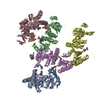
| ||||||||||||||||||||||||||||||||||||||||||||||||
|---|---|---|---|---|---|---|---|---|---|---|---|---|---|---|---|---|---|---|---|---|---|---|---|---|---|---|---|---|---|---|---|---|---|---|---|---|---|---|---|---|---|---|---|---|---|---|---|---|---|
| 1 | 
| ||||||||||||||||||||||||||||||||||||||||||||||||
| 2 | 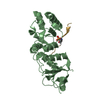
| ||||||||||||||||||||||||||||||||||||||||||||||||
| 3 | 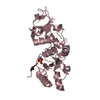
| ||||||||||||||||||||||||||||||||||||||||||||||||
| 4 | 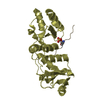
| ||||||||||||||||||||||||||||||||||||||||||||||||
| 5 | 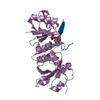
| ||||||||||||||||||||||||||||||||||||||||||||||||
| 6 | 
| ||||||||||||||||||||||||||||||||||||||||||||||||
| 7 | 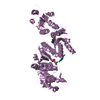
| ||||||||||||||||||||||||||||||||||||||||||||||||
| Unit cell |
| ||||||||||||||||||||||||||||||||||||||||||||||||
| Noncrystallographic symmetry (NCS) | NCS domain:
NCS domain segments: Component-ID: 1 / Ens-ID: 1 / Beg auth comp-ID: ARG / Beg label comp-ID: ARG / End auth comp-ID: PRO / End label comp-ID: PRO / Refine code: 4
|
- Components
Components
| #1: Protein | Mass: 24531.234 Da / Num. of mol.: 5 / Fragment: BRCT DOMAIN 1646-1859 Source method: isolated from a genetically manipulated source Source: (gene. exp.)  Homo sapiens (human) / Gene: BRCA1 / Production host: Homo sapiens (human) / Gene: BRCA1 / Production host:  #2: Protein/peptide | Mass: 1853.038 Da / Num. of mol.: 5 / Source method: obtained synthetically / Details: In vitro optimized phosphopeptide Has protein modification | Y | |
|---|
-Experimental details
-Experiment
| Experiment | Method:  X-RAY DIFFRACTION / Number of used crystals: 1 X-RAY DIFFRACTION / Number of used crystals: 1 |
|---|
- Sample preparation
Sample preparation
| Crystal | Density Matthews: 2.5 Å3/Da / Density % sol: 50.9 % |
|---|---|
| Crystal grow | Temperature: 298 K / pH: 5.6 Details: PEG 4000 ammonium acetate, tri-sodium citrate, pH 5.6, VAPOR DIFFUSION, HANGING DROP, temperature 298K, pH 5.60 |
-Data collection
| Diffraction | Mean temperature: 100 K |
|---|---|
| Diffraction source | Source:  SYNCHROTRON / Site: SYNCHROTRON / Site:  ALS ALS  / Beamline: 5.0.3 / Wavelength: 1.11 / Beamline: 5.0.3 / Wavelength: 1.11 |
| Detector | Type: ADSC QUANTUM 4 / Detector: CCD / Date: Jan 27, 2004 |
| Radiation | Protocol: SINGLE WAVELENGTH / Monochromatic (M) / Laue (L): M / Scattering type: x-ray |
| Radiation wavelength | Wavelength: 1.11 Å / Relative weight: 1 |
| Reflection | Resolution: 3.303→50 Å / Num. obs: 20289 / % possible obs: 99.9 % / Rmerge(I) obs: 0.125 / Net I/σ(I): 11.1 |
| Reflection shell | Resolution: 3.3→3.42 Å / Rmerge(I) obs: 0.5 / Mean I/σ(I) obs: 2.7 / % possible all: 99.9 |
- Processing
Processing
| Software |
| ||||||||||||||||||||||||||||||||||||||||||||||||||||||||||||||||||||||||||||||||||||||||||||||||||||||||||||||||||||||||||||||||||||||||||||||||||||||||||||||||
|---|---|---|---|---|---|---|---|---|---|---|---|---|---|---|---|---|---|---|---|---|---|---|---|---|---|---|---|---|---|---|---|---|---|---|---|---|---|---|---|---|---|---|---|---|---|---|---|---|---|---|---|---|---|---|---|---|---|---|---|---|---|---|---|---|---|---|---|---|---|---|---|---|---|---|---|---|---|---|---|---|---|---|---|---|---|---|---|---|---|---|---|---|---|---|---|---|---|---|---|---|---|---|---|---|---|---|---|---|---|---|---|---|---|---|---|---|---|---|---|---|---|---|---|---|---|---|---|---|---|---|---|---|---|---|---|---|---|---|---|---|---|---|---|---|---|---|---|---|---|---|---|---|---|---|---|---|---|---|---|---|---|
| Refinement | Method to determine structure:  MOLECULAR REPLACEMENT / Resolution: 3.3→50 Å / Cor.coef. Fo:Fc: 0.849 / Cor.coef. Fo:Fc free: 0.814 / SU B: 31.291 / SU ML: 0.541 / TLS residual ADP flag: LIKELY RESIDUAL MOLECULAR REPLACEMENT / Resolution: 3.3→50 Å / Cor.coef. Fo:Fc: 0.849 / Cor.coef. Fo:Fc free: 0.814 / SU B: 31.291 / SU ML: 0.541 / TLS residual ADP flag: LIKELY RESIDUALIsotropic thermal model: overall, with group TLS thermal parameters Cross valid method: THROUGHOUT / σ(F): 0 / ESU R Free: 0.669 / Stereochemistry target values: MAXIMUM LIKELIHOOD
| ||||||||||||||||||||||||||||||||||||||||||||||||||||||||||||||||||||||||||||||||||||||||||||||||||||||||||||||||||||||||||||||||||||||||||||||||||||||||||||||||
| Solvent computation | Ion probe radii: 0.8 Å / Shrinkage radii: 0.8 Å / VDW probe radii: 1.4 Å / Solvent model: BABINET MODEL WITH MASK | ||||||||||||||||||||||||||||||||||||||||||||||||||||||||||||||||||||||||||||||||||||||||||||||||||||||||||||||||||||||||||||||||||||||||||||||||||||||||||||||||
| Displacement parameters | Biso mean: 66.91 Å2
| ||||||||||||||||||||||||||||||||||||||||||||||||||||||||||||||||||||||||||||||||||||||||||||||||||||||||||||||||||||||||||||||||||||||||||||||||||||||||||||||||
| Refinement step | Cycle: LAST / Resolution: 3.3→50 Å
| ||||||||||||||||||||||||||||||||||||||||||||||||||||||||||||||||||||||||||||||||||||||||||||||||||||||||||||||||||||||||||||||||||||||||||||||||||||||||||||||||
| Refine LS restraints |
| ||||||||||||||||||||||||||||||||||||||||||||||||||||||||||||||||||||||||||||||||||||||||||||||||||||||||||||||||||||||||||||||||||||||||||||||||||||||||||||||||
| Refine LS restraints NCS | Ens-ID: 1 / Number: 1398 / Refine-ID: X-RAY DIFFRACTION
| ||||||||||||||||||||||||||||||||||||||||||||||||||||||||||||||||||||||||||||||||||||||||||||||||||||||||||||||||||||||||||||||||||||||||||||||||||||||||||||||||
| LS refinement shell | Resolution: 3.3→3.39 Å / Total num. of bins used: 20 /
| ||||||||||||||||||||||||||||||||||||||||||||||||||||||||||||||||||||||||||||||||||||||||||||||||||||||||||||||||||||||||||||||||||||||||||||||||||||||||||||||||
| Refinement TLS params. | Method: refined / Refine-ID: X-RAY DIFFRACTION
| ||||||||||||||||||||||||||||||||||||||||||||||||||||||||||||||||||||||||||||||||||||||||||||||||||||||||||||||||||||||||||||||||||||||||||||||||||||||||||||||||
| Refinement TLS group |
|
 Movie
Movie Controller
Controller



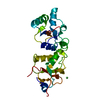

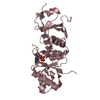
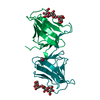
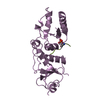
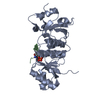
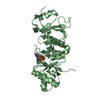

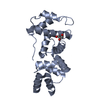
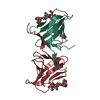
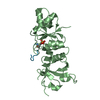
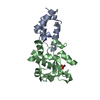
 PDBj
PDBj















